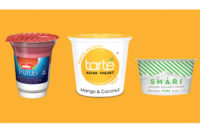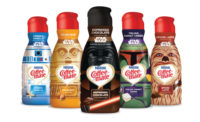The Yogurt Wars
Athenos, Chobani and Fage unveiled national advertising campaigns within weeks of each other.

Beginning in February, three Greek yogurt brands (Fage, Chobani and Athenos) launched first-ever national television advertising campaigns supported with social media efforts.
One of the most stunning is a 45-second commercial titled “Plain” for Fage Total Greek nonfat flavored yogurts, including Mango Guanabana and Blueberry Acai. The spot, by Mullen, a Boston-based advertising agency, started running in March. It uses live action and computer animation to show a long-haired woman, a calf and colorful fruit set against plain white milk. Actor Willem Dafoe reads words, which have been likened (favorable and unfavorably) to a Dr. Seuss rhyme.
This commercial and a series of 15-second spots are the company’s first TV ads in North America. Writing on the website Mediabistro, Stephanie Murg called the ads “anything but plain.” One reader left the comment, “how on earth did they manage to make yogurt look this sexy?” while another wrote on the Mullen website, “It’s just bad all around.”
Mullen’s Mark Wenneker said in a statement, “If our advertising is half as good as the yogurt, I will be pleased.”
Agro Farma started the “yogurt wars” in mid-February when it debuted a series of ads for its Chobani Greek yogurt brand. Titled “Real Love Stories,” the campaign includes two national television commercials along with digital and out-of-home ads. (Read more on page 44.)
The television commercials tell the true stories of fans Stephen Wright and Stephanie Lane. Wright is a college student who biked 80 miles to New Berlin, N.Y., to see Chobani’s processing facility. Lane is a certified public accountant who was frustrated by co-workers who stole her yogurt from the office refrigerator.
VP of marketing Doron Stern tells Dairy Foods that the results have been “staggering.” Retail sales and website traffic have increased as a result of the campaign, he says.
“The love we’ve seen since Chobani first hit stores in 2007 has been overwhelming,” says Hamdi Ulukaya, president and founder of Agro Farma, Norwich, N.Y. “We have the best fans in the world and this campaign celebrates them and their passion for the brand.”
Those fans are called “Chobaniacs” who share their love of the yogurt on social media platforms such as Twitter, Facebook and YouTube. Wright and Lane shared their passion on Facebook, leading to their roles in the TV advertisements.
“Our aim with this campaign was to tap into, amplify and extend the current phenomenon of Chobani ‘love’ that is already spreading across the nation,” says Peter McGuinness, CEO of Gotham Inc., the New York ad agency that developed the spots. “People love good brands that make good products. It’s no more complicated than that.”
Kraft Foods tapped a Greek grandmother (yiayia) to promote its Athenos brand of Greek yogurt, as well as hummus, feta cheese and pita chips. This campaign is centered on Athenos products that are made simply, with respect for traditional ingredients, and yiayia’s approval of them.
Athenos brand manager Marshall Hyzdu says these grandmothers are “blunt, yet relatable Greek yiayias with old-school mentalities” who share unsolicited opinions of modern situations.
In the spot for yogurt, a young woman and man are at a breakfast table. Finding out that the two live together and are not married, yiayia tells them, “You are going to hell.” In the ad for hummus, yiayia tells a young woman in a party dress, “You dress like a prostitute.”
Created by the New York-based advertising agency Droga5, the TV spots are designed to appeal to women in their 20s and 30s who are making the transition from college to life away from their parents. Athenos market research shows that this group seeks foods made with simple ingredients “that don’t compromise flavor.”
“We’re reinforcing what our consumers like, which is products made the traditional Greek way with simple ingredients,” Hyzdu says. That includes its Greek yogurt, made without preservatives or artificial flavors.
In addition to television ads, Athenos will be supporting the campaign and the brand’s portfolio of products through integrated marketing strategies, including social media engagement, digital integration and in-store communications.
Kraft’s spokeswoman Angela Wiggins says, “We’ve taken a very different approach to marketing this year through a provocative creative campaign. The campaign is centered on what we as a brand stand for, which is products made simply and with respect for ingredients. Creatively we bring that to life through a funny, witty, yet relatable traditional grandmother persona, yiayia, to establish a stronger connection between us and consumers.”
The ads have consumers talking. If the talk is converted to purchasing, then the campaigns will be deemed successful.
Jim Carper, chief editor
Meanwhile, Perry’s Ice Cream, Akron, N.Y., won for Most Innovative Novelty for its Sour Buddie Bars, which will be available this spring at retail locations in sour green apple or sour blue raspberry sherbet with a vanilla ice cream center, and Most Innovative Ice Cream Flavor for its red velvet-flavored ice cream, which is a red velvet cake base with cream cheese-flavored swirls. It is now available at ice cream stands in New York and Western Pennsylvania.
“It is an honor to be selected for the IDFA awards by our respected peers in the dairy industry. Red Velvet is one of the hottest trends in food right now and our Sour Buddie bars were developed with a fun, younger consumer in mind,” says Robin Waite, research and quality team leader for Perry’s.
The IDFA awards honor the top ice cream innovations in the dairy industry. This year’s competition was sponsored by Dairy Foods and featured contestants from around the country. A panel of 110 judges from across the dairy industry selected the winners; there were 18 entries in three categories. The conference also included presentations and discussion on key issues in the industry, such as sensory evaluation and product concept testing, implementation of the Food Safety Modernization Act, ice cream’s place in a healthy diet, new and traditional sweetener options and sustainability in the frozen dessert industry.
“This annual contest provides a unique opportunity to spot new trends,” says Cary Frye, IDFA vice president for regulatory and scientific affairs. “From unusual combinations such as strawberries and peppercorns to more traditional flavors like coconut cream pie, the annual contest showcases the creativity of our ice cream and frozen dessert makers.”
Dairy Leads Participation in EPA Energy Star Challenge
In January 2010, the International Dairy Foods Association (IDFA), Washington, D.C., entered into a partnership agreement with the U.S. Environmental Protection Agency, also in Washington, D.C., to promote energy efficiency in the dairy processing industry. Among the envisioned activities are the Energy Star Challenge, a national call-to-action to improve the energy efficiency of America’s industrial facilities and the development of an energy management guide and energy performance indicators.
The challenge launched in May, and since then, 97 dairy facilities have enrolled in the program, representing nearly half of all manufacturing companies currently participating in the program.
“The challenge is open to all industries, not just the beverage or food industry, so our participation stands out and is very much appreciated,” says Clay Detlefsen, IDFA vice president of regulatory affairs.
Because the program operates on a rolling enrollment, new facilities are welcome to participate at any time. The Energy Star program also will be featured during a panel discussion at the IDFA Sustainability Symposium, May 25-26 in Chicago. The session will demonstrate how companies are leveraging the Energy Star program to meet company goals. For instance, one company will explain how it achieved a 10% energy reduction, while another will discuss how it succeeded in getting all of its facilities to participate. Both will share best practices for implementing energy-saving techniques and making the most of their successes within their companies and their customers.
To learn more about the Energy Star program, contact Detlefsen at cdetlefsen@idfa.org.
Upcoming Events from the IDFA
May 10-11
Dairy Cost Accounting WorkshopRosemont, Ill.
May 25-26
Dairy Sustainability SymposiumChicago
June 22-23
Washington Conference Washington, D.C.
Find details about all of these events at www.idfa.org

Advertising for Greek Yogurt Brands Goes Prime Time
Here’s a recipe for creating buzz about a rather hum-drum dairy product: To milk, add a couple of live cultures. Blend with a creative ad agency. Then stand back for praise (or scorn) from fans (or detractors) on blogs and Twitter.Beginning in February, three Greek yogurt brands (Fage, Chobani and Athenos) launched first-ever national television advertising campaigns supported with social media efforts.
One of the most stunning is a 45-second commercial titled “Plain” for Fage Total Greek nonfat flavored yogurts, including Mango Guanabana and Blueberry Acai. The spot, by Mullen, a Boston-based advertising agency, started running in March. It uses live action and computer animation to show a long-haired woman, a calf and colorful fruit set against plain white milk. Actor Willem Dafoe reads words, which have been likened (favorable and unfavorably) to a Dr. Seuss rhyme.
This commercial and a series of 15-second spots are the company’s first TV ads in North America. Writing on the website Mediabistro, Stephanie Murg called the ads “anything but plain.” One reader left the comment, “how on earth did they manage to make yogurt look this sexy?” while another wrote on the Mullen website, “It’s just bad all around.”
Mullen’s Mark Wenneker said in a statement, “If our advertising is half as good as the yogurt, I will be pleased.”
Agro Farma started the “yogurt wars” in mid-February when it debuted a series of ads for its Chobani Greek yogurt brand. Titled “Real Love Stories,” the campaign includes two national television commercials along with digital and out-of-home ads. (Read more on page 44.)
The television commercials tell the true stories of fans Stephen Wright and Stephanie Lane. Wright is a college student who biked 80 miles to New Berlin, N.Y., to see Chobani’s processing facility. Lane is a certified public accountant who was frustrated by co-workers who stole her yogurt from the office refrigerator.
VP of marketing Doron Stern tells Dairy Foods that the results have been “staggering.” Retail sales and website traffic have increased as a result of the campaign, he says.
“The love we’ve seen since Chobani first hit stores in 2007 has been overwhelming,” says Hamdi Ulukaya, president and founder of Agro Farma, Norwich, N.Y. “We have the best fans in the world and this campaign celebrates them and their passion for the brand.”
Those fans are called “Chobaniacs” who share their love of the yogurt on social media platforms such as Twitter, Facebook and YouTube. Wright and Lane shared their passion on Facebook, leading to their roles in the TV advertisements.
“Our aim with this campaign was to tap into, amplify and extend the current phenomenon of Chobani ‘love’ that is already spreading across the nation,” says Peter McGuinness, CEO of Gotham Inc., the New York ad agency that developed the spots. “People love good brands that make good products. It’s no more complicated than that.”
Kraft Foods tapped a Greek grandmother (yiayia) to promote its Athenos brand of Greek yogurt, as well as hummus, feta cheese and pita chips. This campaign is centered on Athenos products that are made simply, with respect for traditional ingredients, and yiayia’s approval of them.
Athenos brand manager Marshall Hyzdu says these grandmothers are “blunt, yet relatable Greek yiayias with old-school mentalities” who share unsolicited opinions of modern situations.
In the spot for yogurt, a young woman and man are at a breakfast table. Finding out that the two live together and are not married, yiayia tells them, “You are going to hell.” In the ad for hummus, yiayia tells a young woman in a party dress, “You dress like a prostitute.”
Created by the New York-based advertising agency Droga5, the TV spots are designed to appeal to women in their 20s and 30s who are making the transition from college to life away from their parents. Athenos market research shows that this group seeks foods made with simple ingredients “that don’t compromise flavor.”
“We’re reinforcing what our consumers like, which is products made the traditional Greek way with simple ingredients,” Hyzdu says. That includes its Greek yogurt, made without preservatives or artificial flavors.
In addition to television ads, Athenos will be supporting the campaign and the brand’s portfolio of products through integrated marketing strategies, including social media engagement, digital integration and in-store communications.
Kraft’s spokeswoman Angela Wiggins says, “We’ve taken a very different approach to marketing this year through a provocative creative campaign. The campaign is centered on what we as a brand stand for, which is products made simply and with respect for ingredients. Creatively we bring that to life through a funny, witty, yet relatable traditional grandmother persona, yiayia, to establish a stronger connection between us and consumers.”
The ads have consumers talking. If the talk is converted to purchasing, then the campaigns will be deemed successful.
Jim Carper, chief editor
IDFA Names Winners at Ice Cream Tech Conference
New frozen desserts that feature salty or sour tastes were among the most innovative trends during the “What’s Your Favorite New Ice Cream Flavor?” contest at the International Dairy Foods Association’s (IDFA), Washington, D.C., annual Ice Cream Technology Conference, March 2-3 in St. Petersburg, Fla. Salted Caramel Chocolate Pretzel ice cream, developed by SensoryEffects Flavor Systems, Bridgeton, Mo., was the most innovative prototype flavor.Meanwhile, Perry’s Ice Cream, Akron, N.Y., won for Most Innovative Novelty for its Sour Buddie Bars, which will be available this spring at retail locations in sour green apple or sour blue raspberry sherbet with a vanilla ice cream center, and Most Innovative Ice Cream Flavor for its red velvet-flavored ice cream, which is a red velvet cake base with cream cheese-flavored swirls. It is now available at ice cream stands in New York and Western Pennsylvania.
“It is an honor to be selected for the IDFA awards by our respected peers in the dairy industry. Red Velvet is one of the hottest trends in food right now and our Sour Buddie bars were developed with a fun, younger consumer in mind,” says Robin Waite, research and quality team leader for Perry’s.
The IDFA awards honor the top ice cream innovations in the dairy industry. This year’s competition was sponsored by Dairy Foods and featured contestants from around the country. A panel of 110 judges from across the dairy industry selected the winners; there were 18 entries in three categories. The conference also included presentations and discussion on key issues in the industry, such as sensory evaluation and product concept testing, implementation of the Food Safety Modernization Act, ice cream’s place in a healthy diet, new and traditional sweetener options and sustainability in the frozen dessert industry.
“This annual contest provides a unique opportunity to spot new trends,” says Cary Frye, IDFA vice president for regulatory and scientific affairs. “From unusual combinations such as strawberries and peppercorns to more traditional flavors like coconut cream pie, the annual contest showcases the creativity of our ice cream and frozen dessert makers.”
Dairy Leads Participation in EPA Energy Star Challenge
In January 2010, the International Dairy Foods Association (IDFA), Washington, D.C., entered into a partnership agreement with the U.S. Environmental Protection Agency, also in Washington, D.C., to promote energy efficiency in the dairy processing industry. Among the envisioned activities are the Energy Star Challenge, a national call-to-action to improve the energy efficiency of America’s industrial facilities and the development of an energy management guide and energy performance indicators.
The challenge launched in May, and since then, 97 dairy facilities have enrolled in the program, representing nearly half of all manufacturing companies currently participating in the program.
“The challenge is open to all industries, not just the beverage or food industry, so our participation stands out and is very much appreciated,” says Clay Detlefsen, IDFA vice president of regulatory affairs.
Because the program operates on a rolling enrollment, new facilities are welcome to participate at any time. The Energy Star program also will be featured during a panel discussion at the IDFA Sustainability Symposium, May 25-26 in Chicago. The session will demonstrate how companies are leveraging the Energy Star program to meet company goals. For instance, one company will explain how it achieved a 10% energy reduction, while another will discuss how it succeeded in getting all of its facilities to participate. Both will share best practices for implementing energy-saving techniques and making the most of their successes within their companies and their customers.
To learn more about the Energy Star program, contact Detlefsen at cdetlefsen@idfa.org.
Upcoming Events from the IDFA
May 10-11
Dairy Cost Accounting WorkshopRosemont, Ill.
May 25-26
Dairy Sustainability SymposiumChicago
June 22-23
Washington Conference Washington, D.C.
Find details about all of these events at www.idfa.org
Looking for a reprint of this article?
From high-res PDFs to custom plaques, order your copy today!








